World War II Chronicle: November 20, 1942
Click here for TODAY’S NEWSPAPER
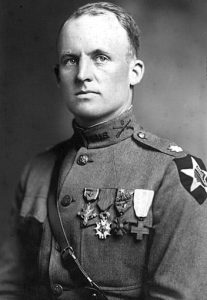
Brig. Gen. Hanford MacNider, commaner of Task Force Buna, is pictured on today’s front page. After serving on the Mexican border, MacNider sailed for Europe with the American Expeditionary Force where he earned two Distinguished Service Crosses (DSC) and three Silver Stars while fighting with Gen. John A. Lejeune’s 2nd Infantry Division. Between wars MacNider commanded the American Legion, was appointed Assistant Secretary of War by Calvin Coolidge and later was the United States Ambassador to Canada.
MacNider led from the front, earning a third DSC during World War II, and was the first American general to be wounded (see page 31 of the Dec. 4, 1942 Chronicle) during World War II. He was blinded in one eye during the Buna campaign by shrapnel, earning him a second Purple Heart. He twice campaigned to become the Republican nominee for president, and later turned down a Cabinet appointment from Pres. Dwight D. Eisenhower, who served as his executive assistant back when MacNider was Assistant War Secretary.
Speaking of Gen. Lejeune, page two reports that the “greatest of all leathernecks” has passed away. Lejeune graduated second in his class at the Naval Academy in 1888. A veteran of the Veracruz campaign and the Spanish-American, Philippine-American, and Banana wars. Gen. John J. Pershing appointed Lejeune commander of the Army’s 2nd Infantry Division, the second — and last — Marine ever to lead an Army division. French Marshal Philippe Pétain, the French Commander-in-Chief during World War I and now head of Vichy France, said Lejeune was “a military genius who could and did do what the other commander said couldn’t be done.” Lejeune would go on to become Marine Corps Commandant, then founded the Marine Corps League. Marine Barracks New River, which opened in 1941, is about to be renamed Camp Lejeune in his honor.
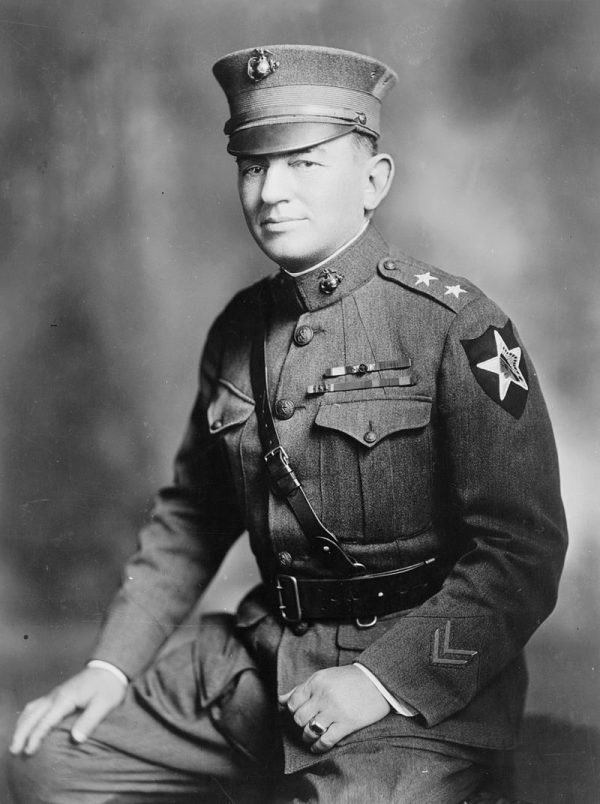
Lejeune’s grandson James B. Glennon, Jr. is a Naval Academy graduate (Class of ’39) and Marine officer, serving in Alaska and the Pacific during World War II. Glennon’s paternal grandfather is Rear Adm. James H. Glennon who joined the Navy in 1874 and served on sail-powered warships, including USS Constellation (1854) which now sits anchored in Baltimore Harbor. Adm. Glennon is the namesake of the Gleaves-class destroyer USS Glennon (DD-620) which was just commissioned in October. Glennon Jr. graduates with William F. Harris who also joins the Marine Corps. Serving with 1st Battalion, 4th Marines on the Philippines, Harris is captured by the Japanese during the Battle of Corregidor. Along with future Indiana governor Edgar Whitcomb, who was an Army Air Force navigator, Harris escaped his captors and swam over eight hours across Manila Bay and joined up with Filipino resistance fighters. Harris later boarded a motorboat and tried to reach China, but the engine died and he spent the next 29 days drifting at sea only to return to the Philippines where he joined another resistance group.
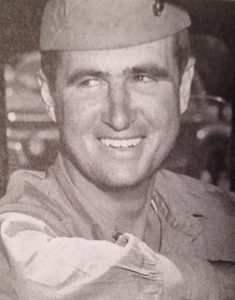
Harris tried to reach Australia, but was recaptured by the Japanese in 1943 and ultimately ended up at Ofuna POW camp, along with former Olympic runner Louis Zamperini and Gregory “Pappy” Boyington. Subjected to particularly extreme treatment, Harris is portrayed in the 2018 film Unbroken, and he was selected to represent U.S. prisoners of war during the Japanese surrender aboard USS Missouri. After the war he marries Jeanne Lejeune Glennon — Gen. Lejeune’s granddaughter. During the Korean War Harris commands the 3rd Battalion, 7th Marines during the Battle of Chosin Reservoir. Lt. Col. Harris’s unit was assigned rear guard duties and he disappeared after being seen heading off with two rifles over his shoulder on Dec. 7, 1950. He was posthumously awarded the Navy Cross. His father Lt. Gen. Field Harris (Naval Academy, Class of 1917) was assistant naval attaché in Cairo where observed Royal Air Force operations in Libya, and later becomes chief of staff of aircraft operations at Guadalcanal. During the Korean War Gen. Harris is commanding general of the 1st Marine Aircraft Wing.
When Lt. Col. Harris led 3rd Battalion at Chosin, 7th Marines’ skipper was Col. Homer L. Litzenberg Jr. In November 1942 “Blitzen Litzen” participated in the amphibious assault at Casablanca. He will ship off to the Pacific where he fights at Roi-Namur, Saipan, and Tinian. A three-time recipient of the Silver Star, Litzenberg will earn the Navy Cross and DSC for his service at Chosin.
Second to None
But back to the 2nd Infantry Division; why were Marine officers leading an Army unit? Because half of the infantry troops were soldiers1The 3rd Infantry Brigade consisted of the 9th and 23rd Infantry Regiments and the 5th Machine Gun Battalion and the other half Marines.2The first Marine units to serve in World War I were the 5th and 6th Marine Regiments and the 6th (Marine) Machine Gun Battalion, which formed the 4th Marine Brigade. Brig. Gen. Charles A Doyen, formerly skipper of the 5th Marines and the 4th Marine Brigade, was appointed Commanding General of the 2nd Division in October 1917. Lejeune was named its commander in July 1918.
Lt. Col. Hiram I. Bearss briefly commanded the 5th Marines after Doyen moved up. Bearss earned the Medal of Honor for leading his Marines up a 200-foot cliff to overwhelm a heavily fortified enemy position on the Philippine island of Samar in 1901. When Bearss leaves to command another Army outfit — the 26th Infantry Division’s 102nd Infantry Regiment, where he earns the Distinguished Service Cross — he is succeeded by Col. Wendell C. Neville. As a young second lieutenant during the Spanish-American War, Neville was part of a daring attack as the Marines stormed ashore at Guantanamo Bay under heavy fire. He earned the Marine Corps Brevet medal for his display of valor — second only to the medal of Honor, which he later earned during the Veracruz campaign. He was also cited for valor during the Boxer Rebellion in China, and is one of only three Americans to earn both the Medal of Honor and the Brevet Medal. In 1929 he becomes the 14th Commandant of the U.S. Marine Corps, succeeding Gen. Lejeune.
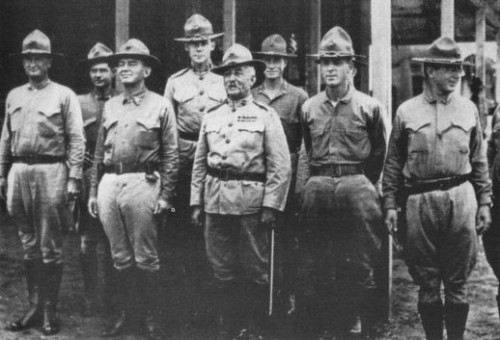
The United States Marine Corps is small enough that there is often a connection, or in this case several connections, between officers. Capt. Bearss was one of two Marine officers to earn the Medal of Honor during the assault on the clifftop stronghold on Samar; the other was Capt. David D. Porter,3Porter’s great-grandfather was Commodore David Porter. His grandfather, David Dixon Porter is the second man in the U.S. Navy promoted to admiral. America’s first admiral was David Farragut, who was David Dixon Porter’s adopted brother. His father Carlisle Patterson Porter also fought in the Civil War. another recipient of both the Medal of Honor and the Brevet Medal. The third man to receive both medals is Smedley D. Butler (pictured above). Butler is also one of a small group of Americans awarded two Medals of Honor for two separate engagements.
Bearss and Porter’s battalion commander is also pictured above: Littleton W.T. Waller, a major when he led Marines on the Philippine island. It was there he met and became close friends with Butler.
At the beginning of Waller’s career he served aboard a ship — and for a captain — that had fought during the Civil War. In 1882 he landed in Alexandria, Egypt to help quell a rebellion. During the Spanish-American War Waller risked his life to save enemy sailors from burning ships after the Battle of Santiago de Cuba. After service in the Philippines he, Neville, and Butler participated in the Relief Expedition to China, where Waller and Butler earned Brevet Medals.
Three of Waller’s sons were high-ranking officers: Littleton Jr. served under his father at Veracruz and was 2nd Division’s machine gun officer during the First World War. He earned the Navy Cross and a Silver Star, and was recently the president of the National Rifle Association. He was recalled to active duty in 1941 and is about to be promoted to brigadier general and named Director of Marine Corps Personnel. John earned the Silver Star while commanding the cruiser USS Tuscaloosa during the Normandy Invasion and retired as a rear admiral. Henry was a Marine brigadier general.
Sports section begins on page 48, which features a column by Grantland Rice.
Evening star. (Washington, D.C.), 20 November 1942. Chronicling America: Historic American Newspapers. Lib. of Congress.
https://chroniclingamerica.loc.gov/lccn/sn83045462/1942-11-20/ed-1/
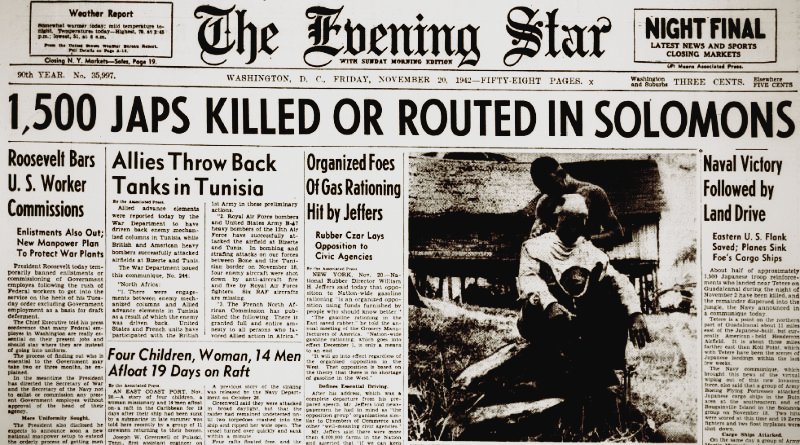
It’s easy to say with the benefit of hindsight what should have happened 80 years ago.
Nazi Germany was collaborating with Muslims to eradicate Middle Eastern Jews once they swept through the Soviet Union. Hitler was truly evil and needed to be stopped and so was Stalin. I see what Patton was getting at, but the problem was we would have lost millions of Americans in a European war that most Americans wanted no part of to begin with. Instead, the Soviets bled Germany white and we finished them off. And look at them now, after the Cold War… we are watching Russia fall apart in real-time. If we weaponized capitalism and exploited our own energy we could marginalize the Chinese Communist Party too.
How many millions of dead Americans would it take for you to have your way of fighting the Soviets? Should we then have followed MacArthur’s plan and fought the Chinese? What about fighting communists in Central and South America? Hell, how about we fight the communists in our own country?
Socialism is evil and appeals to a great percentage of humans across the world. It’s not a problem you can kill your way out of.
The United States made Europe and China Communist.
If the anti-Communist side had won then Europe would not be Islamic today.
Patton was right – we “fought the wrong enemy”.